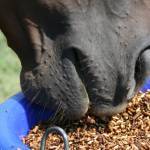Colic in Horses: Avoid Feeding Large Meals

Many owners feed horses their hay and concentrate in “meals,” usually twice daily. This management style, however convenient, is in stark contrast to how undomesticated horses eat. Left to their own devices, horses will graze approximately 16-18 hours per day, all the while moving about. In addition to setting up horses for gastric ulcer syndrome and stereotypies, those fed meals also have an increased risk of colic.
According to Anthony Blikslager, D.V.M., Ph.D., a board-certified surgeon from North Carolina State University’s College of Veterinary Medicine, “meal feeding creates large changes in water movement in and out of the colon and alters the microbiome.”
In a recent publication, he described specific types of colic* associated with feeding meals, including the following:
Simple small intestinal obstruction. This occurs due to a physical obstruction of the intestine. Masses within the intestine, usually comprised of packed feed material, impede the flow of ingesta beyond the obstruction. These obstructions commonly occur in the ileum, which is the final few feet of the small intestine. Secondary to the obstruction, fluid builds up in the small intestine preceding the mass, causing distention of the intestine. This commonly occurs in the southeastern United States, and is thought to be related to ingestion of coastal Bermuda hay.
“This is a fine-textured grass that, if improperly chewed, can get caught at the ileocecal junction, blocking the flow of ingesta from the small intestine to the cecum. The solution to this problem is to introduce coastal Bermuda hay slowly to horses unaccustomed to this forage,” advised Catherine Whitehouse, M.S., a nutrition advisor for Kentucky Equine Research. Further, only good-quality coastal Bermuda hay should be offered to horses. Overmature or stemmy coastal Bermuda should be avoided.
Large colon impaction. The underlying blockage is usually feed material. Due to the anatomy of the large colon, which includes a decreased diameter at the right dorsal colon, large colon impactions occur frequently, often when performance horses suffer a musculoskeletal injury and suddenly require stall rest.
“Another factor thought to contribute to large colon impactions is feeding meals twice daily with concentrates. In these horses, large volumes of water are pulled from the bloodstream into the small intestine as the concentrates travel the length of this organ,” Whitehouse described. “The body responds by resorbing water from the large intestine. This, however, can dehydrate the colon contents causing impactions with the dried ingesta.
These intestinal fluid fluxes, Blikslager wrote, can be moderated by frequent feedings, even dividing the day’s total allotment into five or six equal meals per day, should a horse require concentrate to maintain optimal body condition.
Fluid changes and altered physiology of the gastrointestinal tract influence motility and contribute to colic. Further, variations in fluid and introduction of soluble carbohydrates from concentrates can trigger shifts in the microbiome.
“Offer horses sufficient forage to meet their daily requirements and to maintain a healthy microbiome. Institute all diet changes slowly, and offer a hindgut buffer such as Kentucky Equine Research’s research-proven product EquiShure to prevent acidosis,” recommended Whitehouse.
Those recommendations align with those made by Blikslager, who recommended preventative measures such as constant access to forage, a diet designed to minimize daily fluctuations in chronic fluid flux, and regular daily exercise.
*Blikslager, A.T. 2019. Colic prevention to avoid colic surgery: A surgeon’s perspective. Journal of Equine Veterinary Science 76:1-5.








